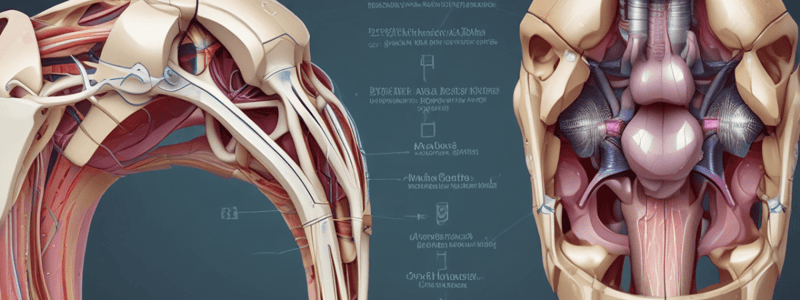Podcast
Questions and Answers
What is the type of knee joint?
What is the type of knee joint?
- Synovial condyloid joint
- Synovial hinge joint (correct)
- Synovial pivot joint
- Synovial ball-and-socket joint
What is the function of the medial collateral ligament?
What is the function of the medial collateral ligament?
- Resists varus angulation
- Stabilizes the patella
- Provides restraint to axial rotation and resists valgus angulation (correct)
- Facilitates knee extension
Which of the following bursae is not located anteriorly?
Which of the following bursae is not located anteriorly?
- Popliteal bursa (correct)
- Prepatellar bursa
- Suprapatellar bursa
- Deep infrapatellar bursa
What is the attachment of the ligamentum patellae?
What is the attachment of the ligamentum patellae?
What are the two bundles of the anterior cruciate ligament?
What are the two bundles of the anterior cruciate ligament?
Which of the following ligaments attaches to the posterior intercondylar of the tibia to the anterior part of the lateral surface of the medial femoral condyle?
Which of the following ligaments attaches to the posterior intercondylar of the tibia to the anterior part of the lateral surface of the medial femoral condyle?
What is the main function of the menisci in the knee joint?
What is the main function of the menisci in the knee joint?
During the last 30 degrees of knee extension, what occurs to the tibia and femur?
During the last 30 degrees of knee extension, what occurs to the tibia and femur?
What is the role of the Vasti and Medialis muscles in knee joint stability?
What is the role of the Vasti and Medialis muscles in knee joint stability?
What is the minor movement of the knee joint caused by the Popliteus and Semitendinosis muscles?
What is the minor movement of the knee joint caused by the Popliteus and Semitendinosis muscles?
Flashcards are hidden until you start studying
Study Notes
Knee Joint
- Largest synovial joint
- Diarthrodial joint
- Articulation between:
- Round condyles of the femur and tibial plateaus and menisci
- Gliding joint between the patella and the patellar surface of the femur
Capsule and Synovium
- Attached to the margins of the articular surfaces and surrounds the sides and posterior aspect of the joint
- Synovial membrane lines the capsule and attaches to the margins of the articular surfaces
Bursae Related to Knee Joint
- Anterior bursae:
- Suprapatellar bursa
- Prepatellar bursa
- Superficial infrapatellar bursa
- Deep infrapatellar bursa
- Posterior bursae:
- Popliteal bursa
- Semimembranosus bursa
Ligaments of the Knee
Extracapsular Ligaments
- Lateral collateral ligament:
- Attachment: from the lateral epicondyle of the femur to the head of the fibula
- Function: resists varus angulation and provides restraint to axial rotation
- Medial collateral ligament:
- Attachment: medial epicondyle of the femur to the medial condyle of the tibia
- Function: resists valgus angulation and provides restraint to axial rotation
- Ligamentum patellae:
- Attachment: lower border of the patella to the tuberosity of the tibia
- Oblique popliteal ligament:
- Derived from the semimembranosus muscle
Intracapsular Ligaments
- Anterior Cruciate Ligament (ACL):
- Bundles: anteromedial (AM) and posterolateral (PL) bands
- Attachment: anteromedial intercondylar area of the tibia to the medial surface of the lateral femoral condyle
- Function: restrains anterior tibial translation and rotational stability
- Posterior Cruciate Ligament (PCL):
- Attachment: posterior intercondylar area of the tibia to the anterior part of the lateral surface of the medial femoral condyle
- Bundles: anterolateral (AL) and posteromedial (PM) bands
- Function: prevents posterior tibial translation in relation to the femur
Menisci
- C-shaped sheets of fibrocartilage
- Medial and lateral menisci connected by transverse ligament of the knee
- Medial meniscus is attached to the capsule, while the lateral meniscus is more mobile
- Function: deepens the articular surfaces of the tibial condyles, serves as cushions between the two bones, and distributes forces transmitted through the joint
Knee Movement
- Main movement:
- Flexion by hamstring muscles: 145-160 degrees
- Extension by quadriceps muscle: 0-5 degrees
- Minor movement:
- Internal rotation by popliteus and semitendinosus: 10 degrees
- External rotation by biceps femoris: 10 degrees
Stability of the Knee Joint
- Bony factors
- Ligamentous factors
- Muscular factors
- Special situations
Muscular Factors
- Vasti muscles
- Medialis (VMO) muscle: important for patella stability
- Ilio-tibial band: stabilizes the slightly flexed knee (varus)
Knee Locking
- During the last 30 degrees of knee extension, the tibia ext.rotates and the femur must internally rotate
- The length of the medial femoral condyle is longer than the length of the lateral condyle
- At terminal extension, the knee joint is slightly hyperextended and stabilized with the tightening of the cruciate and collateral ligaments
Studying That Suits You
Use AI to generate personalized quizzes and flashcards to suit your learning preferences.



